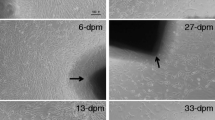Abstract
Donor cell lines were developed from skin tissue for the conservation of the endangered Jaiselmeri camel breed of India. Average cell proliferation rates varied from 0.82 to 0.69 in different passages, and population doubling time from 29.3 h to 34.8 h. Around 15 population doublings were accomplished during this culturing. Cell viability was 97 to 99% in different passages. Growth curves of cells from the JC-5 cell line reached a plateau on day 7, while the slower-growing cultures of JC-3 showed elevation even on day 10, possibly due to donor age differences. Cell proliferation rates by both cell count and MTT absorbance showed similar patterns, with a correlation coefficient of 0.79._MTT assay, a colorimetric method, can handle large samples in somatic cell cultures. Diploid chromosomal counts in passages 1, 3 and 5 were normal (2N=74, XY) in 97% of the cells. Occasional metaphase plates showed polyploidy. The present baseline data on standard growth curve, linear relationship in colorimetric assay for estimation of cell proliferation rate, and normal ploidy and karyological levels in camel skin fibroblast cells in multiplication could be useful in developing competent donor somatic cell lines for conservation now and revival of this camel breed by cloning in the future.
Access this chapter
Tax calculation will be finalised at checkout
Purchases are for personal use only
Preview
Unable to display preview. Download preview PDF.
Similar content being viewed by others
References
Campbell, K.H.S. 1999. Nuclear equivalence, nuclear transfer, and the cell cycle. Cloning, 1: 3–15.
Cibelli, J.B., Stice, S.L, Golucke, P.J., Kane, J.J., Jeny, J., Blackwell, C., Ponce de Leon, F.A. & Robl, J.M. 1998. Cloned transgenic calves produced from non-quiescent fetal fibroblasts. Science, 280: 1256–1258.
Cunningham, E.P. 1999. Recent developments in biotechnology as they relate to animal genetic resources for food and agriculture. FAO Commission on Genetic Resources for Food and Agriculture. Background Study Paper, No. 10. See: ftp://ext.ftp.fao.org/ag/cgrfa/BSP/bsp10E.pdf
Dinnyes, A., Dal, Y.P., Barber, M., Liu, L., Xu, J., Zhou, P.L. & Yang, X.Z. 2001. Development of cloned embryos from adult rabbit fibroblasts: effect of activation treatment and donor cell preparation. Biology of Reproduction, 64: 257–263.
Gupta, N., Sharma, R., Taneja, R., Sisodia, B.S., Singla, S.K., Singh, G. & Gupta, S.C. 2002. Growth curve and ploidy levels in multiple passaging of buffalo skin fibroblast cells in culture. In: Proceedings 4th Asian Congress on Buffaloes. New Delhi, 22–23 February 2003.
Hare, W.C.D. & Singh, E.L. 1979. Cytogenetics in Animal Reproduction. Wallingford, UK: Commonwealth Agricultural Bureaux.
Kato, Y., Tani, T., Solomaru, Y., Kurokawa, A., Kato, J., Doguchi, H., Yasue, H. & Tsunoda, Y. 1998. Eight calves cloned from somatic cells of a single adult. Science, 282: 2095–2098.
Kubota, C., Yamakuchi, H., Todoroki, J., Mizoshita, K., Tabara, N., Barber, M. & Yang, X. 2000. Six cloned calves produced from adult fibroblast cells after long-term culture. Proceedings of the National Academy of Sciences, USA, 97(3): 990–995
Maghni, K., Nicolescu, O.M. & Martin, J.G. 1999. Suitability of cell metabolic colorimetric assays for assessment of CD4+ T cell proliferation: comparison to 5-bromo-2-deoxyuridine (BrdU) ELISA. Journal of Immunological Methods, 223(2): 185–194.
Mehra, K.L. 2001. Animal Biotechnologies: benefits and concerns. In: Proceeding of National Workshop on Conservation and Management of Genetic Resources of Livestock. National Academy of Agricultural Sciences, New Delhi.
Onishi, A., Iwamoto, M., Akita, T., Mikawa, S., Takeda, K., Awata, T., Hanada, H. & Perry, A.C. 2000. Pig cloning by microinjection of fetal fibroblast nuclei. Science, 289(5482): 1188–1190.
Polejaeva, I.A., Chen, S.H., Vaught, T.D., Page, R.L., Mullins, J., Ball, S., Dai, Y., Boone, J., Walker, S., Ayares, D.L., Colman, A. & Campbell, K.H.S. 2000. Cloned pigs produced by nuclear transfer from adult somatic cells. Nature, 407: 86–90.
Wakayama, T., Perry, A.C.F., Zuccott, M., Johnson, K.R. & Yangimachi, R. 1998. Full term development of mice from enucleated oocytes injected with cumulous cell nuclei. Nature, 394: 369–374.
Wells, D.N., Misica, P.M., Tervit, H.R. & Vivanco, W.H. 1998. Adult somatic cell nuclear transfer is used to preserve the last surviving cow of the Enderby Island cattle breed. Reproduction Fertility and Development, 10: 369–378.
Wemme, H., Pfeifer, S., Heck, R. & Muller-Quernheim, J. 1992. Measurement of lymphocyte proliferation: critical analysis of radioactive and photometric methods. Immunobiology, 185(1): 78–79.
White, K.L., Bunch, T.O., Mitalipov, S. & Reed, W.A. 1999. Establishment of pregnancy after the transfer of nuclear embryos produced from the fusion of argali (Ovis ammon) nuclei in to domestic sheep (Ovis aries) enucleated oocytes. Cloning1(1): 47–54.
Wilmut, I., Schnieke, A.E., Mcwhir, J., Kind, A.J. & Campbell, K.H. 1997. Viable offspring derived from fetal and adult mammalian cells. Nature, 385: 810–813.
Author information
Authors and Affiliations
Editor information
Editors and Affiliations
Rights and permissions
Copyright information
© 2005 IAEA
About this paper
Cite this paper
Gupta, S. et al. (2005). In Vitro Culture of Skin Fibroblast Cells for Potential Cloning by Nuclear Transfer. In: Makkar, H.P., Viljoen, G.J. (eds) Applications of Gene-Based Technologies for Improving Animal Production and Health in Developing Countries. Springer, Dordrecht. https://doi.org/10.1007/1-4020-3312-5_47
Download citation
DOI: https://doi.org/10.1007/1-4020-3312-5_47
Publisher Name: Springer, Dordrecht
Print ISBN: 978-1-4020-3311-7
Online ISBN: 978-1-4020-3312-4
eBook Packages: Biomedical and Life SciencesBiomedical and Life Sciences (R0)




